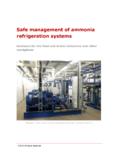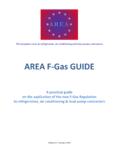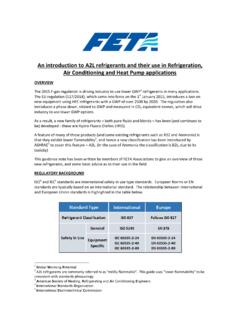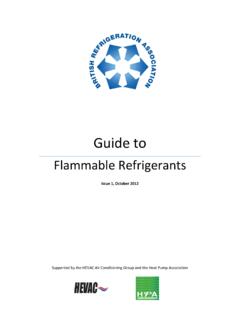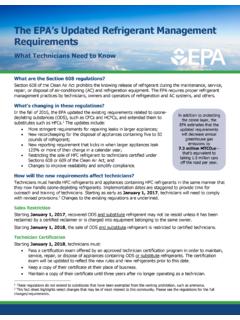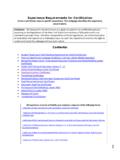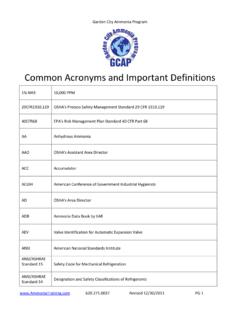Transcription of AREA F-Gas GUIDE - Refcom
1 The European voice of refrigeration , air conditioning and heat pumps contractors area F-Gas GUIDE A practical GUIDE on the application of the new F-Gas Regulation to refrigeration , air conditioning & heat pump contractors Edition 03 October 2016 2 All rights reserved October 2016 area Editor: Olivier Janin, Secretary General area The European association of refrigeration , air conditioning and heat pump contractors | 3 CONTENTS LIST OF ACRONYMS ..4 FOREWORD ..5 I- Legal basis ..6 II- Definitions ..6 III- Prevention of emissions ..7 IV- Leakage prevention and treatment ..8 V- Record keeping .. 15 VI- Recovery .. 16 VII- Training & certification .. 18 VIII- Bans .. 21 IX- Delivery of f-gases .. 24 X- Sale of pre-charged equipment .. 26 XI- Labelling of recycled/reclaimed refrigerant.
2 27 XII- Service ban .. 27 XIII- Pre-charging of equipment .. 29 XIV- Phase-down of HFCs .. 29 ANNEX 1 Relevant key dates .. 33 ANNEX 2 - Correlation table .. 35 ANNEX 3 Equivalence old and new Fgas legislation .. 36 ANNEX 4 - Delivery of F-Gases .. 37 ANNEX 5 Useful links .. 39 4 LIST OF ACRONYMS A/C Air conditioning area European association of refrigeration , air conditioning and heat pump contractors1 CO2-eq / CO2e CO2-equivalent ENER DG Energy of the European Commission ENTR DG Enterprise & Industry of the European Commission EPEE European Partnership for Energy and the Environment2 EU European Union FAQ Frequently Asked Questions GWP Global warming potential HFC Hydrofluorocarbons IPCC Intergovernmental Panel on Climate Change3 Kg Kilogramme kW Kilo-watt PFC Perfluorocarbon RACHP refrigeration , air conditioning and heat pump SF6 Sulfur hexafluoride t Tonne TFUE Treaty on the functioning of the European Union 1 2 3 5 FOREWORD Regulation (EU)
3 No 517/20144 on fluorinated greenhouse gases aims at reducing emissions of these gases through a variety of measures: rules on containment, use, recovery and destruction of fluorinated greenhouse gases, conditions on the placing on the market of certain types of products or equipment containing or relying upon fluorinated greenhouse gases (bans), specific uses of these gases (service ban), quantitative limits for the placing on the market of HFCs (phase-down). In November 2012, the European Commission proposed to revise Regulation (EC) No 842/2006 on certain fluorinated greenhouse gases. This revision resulted in Regulation (EU) No 517/2014 of the European Parliament and of the Council of 16 April 2014 on fluorinated greenhouse gases and repealing Regulation (EC) No 842/2006. It was published in the Official Journal of the EU on 20th May 2014 and entered into force on 9th June 2014.
4 The new Regulation will be applicable from 1st January 2015. The purpose of this area GUIDE is to explain the main changes and obligations arising from the revision, and to identify their consequences for European refrigeration , air conditioning & heat pump contractors. It also sets out the views of area on the practical implementation and interpretation of certain provisions in order to ensure that their objectives are fulfilled. This GUIDE has to be put into perspective with and complements the European Commission s guidelines on Regulation (EU) No 517/2014 on fluorinated greenhouse gases that will be provided successively after consultation of the Member States. The guidance contained in the present document reflects the best knowledge of industry experts across Europe and the state of the art at the moment of its publication.
5 This GUIDE will be regularly updated to accommodate latest developments. To ensure that your copy is up to date, please check area s website The principles contained in this GUIDE are however not legally binding, and following it gives no guarantees. Contractors must ultimately exercise their own judgement. A binding interpretation of Community legislation is the exclusive competence of the European Court of Justice. area also recommends to contractors, when using this GUIDE , to always refer to the national legislation, and guidance if any, of the Member State they are dealing with. area is the European association of refrigeration , air conditioning and heat pump contractors. Established in 1989, area voices the interests of 23 national associations from 20 European countries, representing more than 13,000 companies (mainly small to medium sized enterprises), employing some 110,000 people and with an annual turnover approaching 23 billion.
6 Contractors are the essential link between end users and manufacturers. They design, install and maintain RACHP equipment using every available solution with complete neutrality towards equipment and refrigerants, in the sole aim of ensuring the highest level of reliability, energy efficiency and cost-effectiveness. 4 6 I- Legal basis The legal basis is the EU Treaty provision(s) on which the Regulation is based. It is relevant insofar as it influences the leeway Member States have when applying the Regulation. Regulation (EC) 842/2006 had a dual legal basis: - Internal market (article 95 - now article 114 TFUE) for its article 7 on Labelling, article 8 on Control of Use and article 9 on Placing on the Market, - Environment (article 175 now article 192 TFUE) for all its other provisions.
7 The new Regulation now has a unique environment basis. This means that provisions on labelling, control of use and, more importantly, placing on the market (bans) are now under an environmental basis. The effect of this change is related to the margin Member States have if they wish to maintain or introduce national measures that are in the scope of the Regulation but create differences. Under an Internal Market basis, a Member State may maintain or introduce new national provisions based on limited reasons ( health protection, protection of the environment). However, they must notify the Commission of their intention and must obtain the Commission s prior approval. Under an environment basis (which includes climate change), Member States may maintain or to introduce more stringent protective measures as long as these are compatible with the Treaties ( respect free circulation of goods, guarantee undistorted competition, be proportional to the objective).
8 They must notify the Commission of their intention but they do not need approval. What effect is to be expected in practice? It is difficult to anticipate Member States reactions. One could imagine that one or the other Member State may apply more stringent labelling measures or even request earlier or wider bans on equipment. However, only experience will tell the margin Member States will actually have so that these potential national measures respect the condition of compatibility with the Treaties. II- Definitions Article 2 The definitions referred to in these guidelines only refer to terms that: - Are relevant to RACHP contactors, and - Are new or have been substantially modified compared to Regulation (EC) 842/2006. Fluorinated greenhouse gases The new Regulation continues to apply to HFCs, PFCs and SF6.
9 HFCs, PFCs and SF6 are not defined in detail (as in the Regulation (EC) No 842/2006); instead reference is made to the annex I, which lists them. 7 It is also specified that mixtures containing any of these substances are also included (Regulation (EC) 842/2006 used to refer to preparations ). A mixture is defined as a fluid composed of two or more substances, at least one of which is a fluorinated greenhouse gas . GWPs are listed in Annexes I, II and non-fluorinated components of mixtures in Annex IV. Annex IV also defines the calculation formula for mixtures. Compared to Regulation (EC) No 842/2006 some changes of GWPs occurred since they are based on the Fourth Assessment Panel report of the IPCC, and no longer on the Third. The listed values apply irrespectively of any changes in later IPCC reports or other scientific or commercial publications.
10 Contractors services The new Regulation aligns the definitions of recovery , recycling and reclamation with those used in Regulation (EC) No 1005/2009 on substances that deplete the ozone layer5. In addition, the new Regulation aligns the definitions of installation and maintenance or servicing with those used in Commission Regulation (EC) No 303/2008 on minimum requirements and the conditions for mutual recognition for the certification of companies and personnel as regards stationary refrigeration , air conditioning and heat pump equipment containing certain fluorinated greenhouse gases6. These activities are based on the common criteria of either completing or breaking into refrigerant circuits. III- Prevention of emissions Article 3 Obligations of the operator The definition of the operator (article 2, 8) remains mostly unchanged: the natural or legal person exercising actual power over the technical functioning of products and equipment covered by this Regulation; a Member State may, in defined, specific situations, designate the owner as being responsible for the operator's obligations The new Regulation carries the operator s duty to take precautions to prevent leakages.
